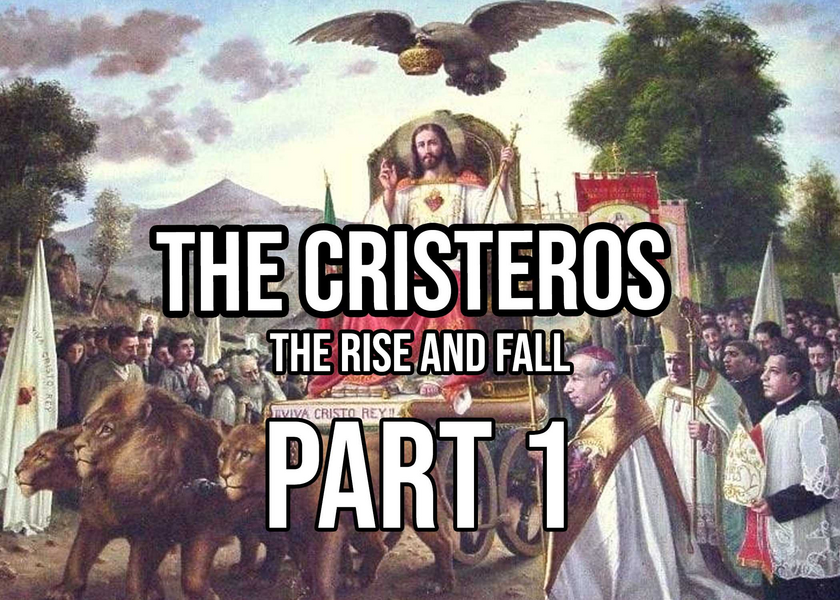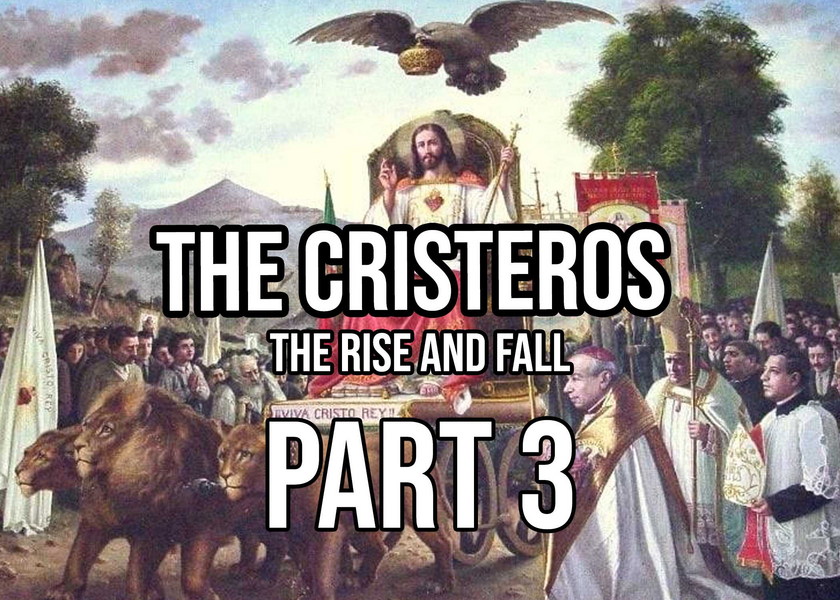By Mark Fellows
Proof that winners write the history books is found in history's treatment of the Cristiada, the peasant rising against the revolutionary government that was persecuting the Church in Mexico in the mid 1920's. English-language history books note the rising in a page or two, making liberal use of adjectives like 'violent,' 'extremist,' and 'fanatical.' The subject is closed by noting that the revolutionary government in Mexico struck a deal with the Vatican and the Church in Mexico wherein the government lost nothing, and many of the peasants - better known as the Cristeros - lost their lives after being ordered by the Church to stop fighting.
In the eyes of the world, the Cristeros were the ultimate losers. Not even their Church supported them at the end. They were not respectable. They were not considered good Catholics by many of their co-religionists. A handful of priests supported them, and fewer bishops. Scorned by the world, the Church, and history, the Cristeros are now but a quirky footnote in the saga of Benign Progress.
At one time, however, they spoke for themselves, in words simple and unbowed by human respect, in tones undaunted by the Revolution, or by historians that seek to swallow the light of the Sun:
"I know only too well that what is beginning now for us is a Calvary. We must be ready to take up and carry our crosses ... If one of you should ask me what sacrifice I am asking of you in order to seal the pact we are going to celebrate, I will tell you in two words: your blood. If you want to proceed, stop dreaming of places of honor, military triumphs, braid, luster, victories, and authority over others. Mexico needs a tradition of blood in order to cement its free life of tomorrow. For that work my life is available, and for that tradition I ask yours…[1]
The Cristeros picked up their weapons when the Church in Mexico closed down. They fought and died until the Church reopened. In the history of the Revolution versus the Church in Mexico, they were followed the same, narrow, bloody path.
They did not begin hostilities, they engaged the hostilities of a godless, violent government with their pitchforks, scythes, knives, horses, and guns. An accurate picture of the Cristeros must balance the nature of their response against the extremities that provoked their response ...
Explosions
The Basilica was filled with people when the main altar seemed to explode. Hidden in a floral arrangement at the foot of the altar, a bomb detonated with force. Chunks of the marble altar were blown into the air. A great iron crucifix was twisted like a pretzel. Behind the mangled altar, the tilma displaying the miraculous image of Our Lady of Guadalupe was somehow untouched by the explosion.
The year was 1921, and the bomb was the most recent in a series of outrages against the Catholic Church in Mexico. A bomb blew up at the door of the Archbishop of Mexico, Monsignor Jose Moray del Rio, when the Archbishop was publicly critical of socialism. A week later the Cathedral in Morelia Michoacan was bombed. When angry Catholics met afterwards, revolutionaries attacked the meeting and killed fifty people.[2]
It was appropriate, in a way, that the explosions and murders occurred during the centenary of Mexico's independence. In 1821 she declared herself free of Spanish rule, and although Roman Catholicism was initially retained as the national religion, the new nation soon found herself under the influences of the Enlightenment, liberalism, and Freemasonry.
Scottish Rite masonry was introduced to Mexico courtesy of the mother country, Spain, who had received Masonry from Bonaparte's France.[3] The sons and daughters of wealthy Mexicans were educated in Europe, and returned as liberals. Of equal influence was Mexico's northern neighbor, the Protestant Masonic United States of America.
Ambassador Poinsett
The American government happily recognized Mexico's independence, but it was not until 1825 that President Monroe appointed as ambassador to Mexico one Joel Roberts Poinsett, a Congressman from South Carolina whose diplomacy set the tone for Mexican American relations.
"Poinsett was an outspoken proponent of U.S. style liberalism: decentralized, constitutional, republican government; anti-clericalism; and free trade ... Poinsett found like-minded cohorts in the York Rite Masonic Lodge, which he helped to organize in Mexico. The York Rite Masons (Yorkinos) were rivals of the Scottish Rite Masons (Escoceses), and the two lodges increasingly emerged as bitter, secretive political clubs."[4]
The Scottish Rite Masons were, relatively speaking, more conservative than the Yorks, seeking influence through the aristocracy and the military. The Yorks were more radical, advocating an uncompromising democracy and destruction of the Church. "The basic ideological cleavage (conservative liberal) was manifested in branches of Freemasonry to which many leaders, including Catholic priests, belonged ... Masonry provided meeting places and support for politicians and plotters during the earliest years of the Mexican republic."[5]
Poinsett's influence is worth noting at some length because it is consistent with later American policies towards Mexico, differing only in degree. Many of Poinsett's assumptions about the Mexican people, and the Church in Mexico, were shared by future American politicians. In his book, Notes From Mexico, Poinsett called the Mexican aristocracy "an ignorant and immoral race." As for the clergy,
"The regular clergy formed from the very dregs of the people, was then and is now disgustingly debauched and ignorant. They have lost the influence they formerly possessed over the common people, and so sensible are they of the universal contempt which they have brought upon themselves by their unworthy conduct, that they would not oppose a thorough reform of their orders if the Government had courage to attempt it."
As for the Indians, "they either gamble away their money, or employ it in pageants of the Catholic Church, in which pagan and Christian rites are strangely mingled. All these evils, if not cured entirely, would be greatly mitigated by education ..."[6] To this end the Grand Lodge of Mexico (York Rite), which Poinsett founded, collaborated with him on a resolution to "Improve the moral condition of the people by depriving the clergy of its monopoly on public education ..."[7]
Poinsett was in Mexico long enough to witness some of the consequences of his ideas, though it is doubtful he equated the weakening of the Church with the weakening of public morals, which resulted in "a pestilence of robbers":
"there were ubiquitous bandits, robbers and pickpockets waiting to remove possessions and threaten lives. Even in Mexico City, the American minister Joel Poinsett and other visitors noted that despite good lighting and patrols, robberies, murders, and assassinations were so frequent that everyone of substance went about heavily armed ... when one visitor reported to the magistrate that he had run through an attacker with his sword and wounded others, he was told that the best advice was to keep quiet about the incident."[8]
Moreover, even if one grants that certain priests were not up to the calling of their office, it is still true that the clergy as a group received far more respect from Mexicans (including bandits) than Poinsett, who was so roundly hated in Mexico that his very presence caused riots.[9] The authors of The Oxford History of Mexico assert that:
"Poinsett developed close ties to radical Mexican congressmen, exerting much influence over them through their membership in the Masonic lodge. His indiscreet participation in Mexican domestic politics even made his friend Vicente Guerrero, president of the Mexican Republic, ask for his recall in 1829."[10]
He is remembered for none of this. Today we know Joel Roberts Poinsett as the amateur botanist who introduced to the United States a Mexican plant often used as a Christmas decoration. Dubbed the Poinsettia by Americans, the Christmas Flower is an ironic legacy for America's first Ambassador to Mexico.
The New Rulers
Poinsett's Masonic comrade in arms, Valentin Gomez Farias, became acting President of Mexico in 1832.[11] He exiled bishops, forbade the Church to educate Mexicans, claimed the power to appoint bishops and other Church officials, and secularized the Franciscan missions of California, seizing their funds and property.[12] The people revolted. Farias' short rule "was a disastrous failure, in that it united all his enemies," even the moderates.[13] General Antonio Lopez de Santa Anna took the reins, let the bishops back into Mexico, and took no action on Farias' other anti-clerical initiatives.
The following thirty years saw Santa Anna move in and out of exile as the power in Mexico shifted from conservative to radical Freemasons: "Freemasonry and the Government were, in fact, closely linked, so closely that it was necessary to be a Mason to be appointed to any important post," including the military.[14] United by their hatred of the Roman Church, Mexican Freemasons didn't seem to like each other very much either. Coup upon coup occurred, overtures of violence replete with bloodshed and glossed by fine rhetoric.
The Mexican government grew and grew, particularly the military, which served as the lever of power in Mexico, but was inept at protecting Mexico from the United States. In the 1840's the United States declared war on Mexico after the Mexican government expelled an American ambassador who offered to buy California. Faced with a common enemy, liberal and conservative Mexican Freemasons stopped killing each other and united, but it was too late. Armed Progress landed at Vera Cruz and marched to Mexico City, which it conquered and occupied. The American army's marching song was
"Green Grow the Rashes O", from which came the derisive Mexican term for North Americans, "gringo." The peace terms exacted a severe price on Mexico.
They lost half their territory for fifteen million dollars, barely enough to temporarily move the Masonic government out of bankruptcy. In return, the United States gained California, Arizona, New Mexico, Colorado, Nevada, and Utah, thus extending its borders from sea to shining sea.
The Laws of Reform
By the 1850's Mexicans had lived under five constitutions and fifty-one presidents.[15] Revolutions, insurrections, and coups were the order of the day. Mexicans reflected the incompetence and murderous temperament of their government, prompting a French ambassador to remark that ''bandit gangs were the only Mexican institution that functioned with perfect regularity."[16]
The Revolution, however, was just warming up. In 1855 the first Laws of Reform were formulated, and they continued in waves for the next decade. The reforms sought to nullify the Church's influence on Mexican culture, and subordinate the Church to the State.
More Church property was taken and sold in order to fill empty government coffers. Civil marriage was introduced, and liberal holidays honoring the revolutionary fathers replaced feast days of the Church. Public worship was banned, as was clerical dress. Religious orders were suppressed. Even church bells were subject to regulation. Catholicism was no longer recognized as the religion of Mexico. Instead, 'religious freedom' was introduced, which meant that the Catholic Church was harassed and Protestant evangelization was encouraged.[17] Many American Protestants were enthusiastic supporters of the Revolution.
"When the Mexican Revolution began, the Protestant churches threw themselves into it almost unanimously because they believed that the progress of the Revolution represented what these churches had been preaching through the years and that the triumph of the Revolution meant the triumph of the Gospel. There were some entire congregations who, led by their pastors, volunteered for service in the Revolutionary Army"[18]
The Church rose in protest over the new laws. The Mexican episcopate had the full support of Pope Pius IX, who responded to the Laws of Reform with this declaration:
"We raise our Pontifical voice in apostolic liberty ... to condemn, reprove and declare null and void everything the said decrees and everything else that the civil authority has done in scorn of the ecclesiastical authority and of this Holy See."[19]
Conservatives in the military and the government revolted. The man responsible for the Laws of Reform, Benito Juarez, fled Mexico City, leaving the conservatives to set up a new government. Juarez eventually landed in Veracruz, setting up his own rival government. So began the War of the Reform, also known as The Three Years War, a bloody civil conflict that decided the future of Mexico - and who would write the history of the country.
The conservative army marched on Veracruz and blockaded the harbor. Things were grim for Juarez until he and his liberal government in exile "were unexpectedly saved by the intervention of the United States, whose government, though itself on the brink of civil war,"[20] sent ships to disable the Mexican ships and end the blockade. The tide of war shifted, and on January 1, 1861, the liberals recaptured Mexico City, thus ending the War of the Reform.
"Their (liberals) triumph officially banished the Conservative version of history. From then on, schoolchildren learned the history of the fatherland, described by Justo Sierra as 'a patriotic religion that unites and unifies us' through 'holy love' and 'deep devotion' for the (Liberal) heroes."[21]
In spite of their new heroes, or perhaps because of them, postwar Mexico was desolate and impoverished. So was the Church, which had
"lost almost all her imposing buildings, which had served as seminaries, colleges, religious houses, or charitable institutions. Almost all the libraries were taken by the government or destroyed. The Church passed through a time of anguish, as did the entire nation, impoverished by wars and discredited before the civilized world. The public treasury was bankrupt, backwardness and poverty were general, and divisions and grudges among the liberal leaders were implacable."[22]
Divisions disappeared where the Church was concerned:
"Eminent Liberals literally picked up axes to destroy altars, church facades, pulpits, and confessionals. Scenes out of the French Revolution were reenacted. Images of saints were decapitated, shot full of holes, burned in public autos-da-fe; Church treasuries were robbed, archives were plundered, ecclesiastical libraries went up in flames.
"Bishops were stoned to death, and Church property was auctioned off. Nuns who had spent their whole lives cloistered were suddenly forced out of their convents. Ocampo ordered the expulsion of all Catholic bishops from the country ... 'The government banishes the bishops,' exclaimed the young Ignacio Manuel Altamirano. 'It ought to hang them!"[23]
The liberal government, despite garnering $45,000,000 from the sale of Church property, was bankrupt, owing $80,000,000 on loans from other countries.[24] This provided the pretext for the next invasion of Mexico by one of its creditors, France. Taking advantage of the United States' Civil War, and intrigued by stories of the vast mineral wealth of Mexico, French Emperor Napoleon III, with the help of well placed Mexican conservatives, installed Archduke Maximilian of Habsburg as Emperor of Mexico. Juarez, "a cunning and ruthless politician who knew how to wait,"[25] returned to exile and bided his time.
Maximilian was about as Catholic as Juarez. He broke off relations with the papal nuncio, and ratified several of Juarez' anti-clerical laws. "The people in cassocks (the priesthood) are evil and weak," Maximilian declared. "The great majority of the country is liberal and wants progress in the most complete sense of the word."[26] The new emperor alienated the conservatives and the Church, and failed to win over the liberals. The other problem Maximilian had was one of succession. He had contracted syphilis from prostitutes, and his wife Carlota refused to know him.[27] His days were numbered, and only the presence of French troops lengthened his reign.
The American Civil War ended sooner than the French had hoped for, and the United States could now show its support for Juarez tangibly.
"Tons of surplus military equipment were transferred to the Mexican republican forces on the border, and about three thousand discharged veterans of the Union army went to Mexico and joined Juarez's forces."[28]
Then, on the pretext of exterminating stubborn Confederates, "General Grant ordered Major General Philip H. Sheridan, a keen liberal like himself, to the border with 42,000 men ... For a time it seemed that the U.S. Army might invade Mexico on behalf of that country's Republicans."[29]
The American government applied diplomatic pressure on Napoleon III to withdraw his troops. Fed up with Mexico, the Emperor complied, leaving Maximilian to twist in the wind.[30]
Carlota returned to France to persuade Napoleon to reconsider, but she became psychotic and was hospitalized in Belgium. She spent the last sixty years of her life insane, never knowing that her husband was captured by Juarez's forces and executed by a firing squad. This needless murder by the Revolution was criticized around the world, even by the United States government. Juarez responded that the execution of Maximilian was
"just, necessary, urgent, and inevitable ... We inherit the indigenous nationality of the Aztecs, and in full enjoyment of it, we recognize no foreign sovereigns, no judges, and no arbiters."[31]
So the list of new liberal heroes expanded to include the murderous Aztecs, whose tradition of shedding innocent blood was assumed by the Revolution. It is interesting that Benito Juarez, a full blooded Zapotec Indian (mortal enemies of the Aztecs) who received his education from the Jesuits, omitted the predominant tradition of blood that defeated the Aztecs: the blood of innocent martyrs for Christ, shed in emulation of the Master in the Christianizing of Mexico. If Juarez had forgotten this overshadowing tradition of blood that defeated the Aztecs, most of Mexico still had not, and many of them determined to take up their cross and follow the Master, even unto death.

















